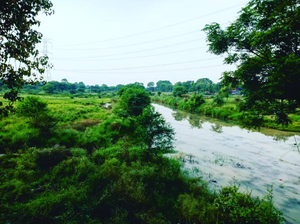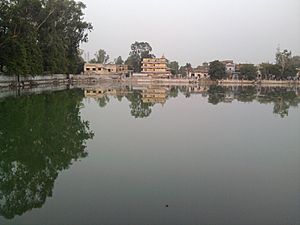Bhadohi district facts for kids
Quick facts for kids
Bhadohi
|
|
|---|---|
| Sant Ravidas Nagar | |

A view of Morva River in Moosilatpur village
|
|
 |
|
| Country | |
| State | Uttar Pradesh |
| Division | Mirzapur |
| Established | 30 June 1994 |
| Headquarters | Gyanpur |
| Tehsils | 3 |
| Area | |
| • Total | 1,015 km2 (392 sq mi) |
| Population
(2011)
|
|
| • Total | 1,578,213 |
| • Density | 1,554.9/km2 (4,027.1/sq mi) |
| Language | |
| • Official | Hindi |
| • Regional | Awadhi |
| Demographics | |
| • Literacy | 89.14% |
| • Sex ratio | 902 |
| Time zone | UTC+05:30 (IST) |
| Vehicle registration | UP-66 |
| Major highways |
|
Bhadohi District is a special area, or district, in the northern part of India, in the state of Uttar Pradesh. Its main city and headquarters is Gyanpur. Bhadohi is famous around the world as the 'Carpet City of India' because it's one of the biggest places where carpets are made.
The carpets from Bhadohi even have a special 'Geographical Indication' (GI) tag. This tag shows that they are truly from this region. Bhadohi is also important because it's located between two old and culturally rich cities: Prayagraj and Varanasi.
Contents
History of Bhadohi
Bhadohi has a long and interesting history, going back thousands of years. Many stories and events have shaped this area.
Ancient Times in Bhadohi
According to the ancient Indian story, the Mahābhārata, the Pandava brothers found a safe place here. They hid in a spot called Semradhnath after escaping through a secret tunnel.
It is also believed that Sita, the wife of Lord Rama, lived here for some time. She stayed at the ashram (a spiritual retreat) of Maharshi Valmiki. People say that Lav and Kush, Lord Rama's twin sons, were born in this very ashram.
Medieval Period of Bhadohi
Bhadohi might have gotten its name from the Bhar Raj kingdom, which had Bhadohi as its capital. You can still find old mounds and tanks named after the Bhar rulers. Later, this area became part of the Jaunpur Kingdom.
During the time of the Mughal Emperor Akbar, Bhadohi was an important administrative area. It was part of the sarkar (a type of district) of Allahabad.
Around the 15th century, the Bhar rulers were taken over by the Monas Rajputs. Sagar Rai was the first leader of this new group. His grandson, Jodh Rai, received a special deed, called a zamindari sanad, from the Mughal Emperor Shah-e-Jahan to rule the land.
Later, around 1750 AD, the area was given to Balwant Singh of Benaras. This happened because the local ruler couldn't pay his taxes. In 1770 AD, Balwant Singh received direct permission to rule from Nawab Shuja-ud-Daula of Awadh.
In 1911, Bhadohi became part of the new princely state of Benares. It stayed under the rule of the Maharaja of Benares until India became independent in 1947.
Modern History of Bhadohi
Bhadohi became its own separate district on June 30, 1994. Before this, it was part of the Varanasi district. It was the 65th district created in the state of Uttar Pradesh.
For a while, the district's name was changed to Sant Ravidas Nagar. However, on December 6, 2014, the government decided to change the name back to Bhadohi.
Geography of Bhadohi District
Bhadohi district is located in the flat plains of the Ganges River. The Ganges River forms the southwestern edge of the district. The main rivers here are the Ganges, Varuna, and Morva.
The district is surrounded by other districts: Jaunpur district to the north, Varanasi district to the east, Mirzapur district to the south, and Prayagraj district to the west. Bhadohi is the smallest district in Uttar Pradesh by area, covering about 1055.99 square kilometers.
There are many important and holy places in Bhadohi. Some famous ghats (steps leading to a river) are Bhoganw and Rampur. Many divine temples can also be found here, including Sita Samahit Sthal (Sitamarhi), Semradhnath Mahadev Dham, Baba Harihar Nath Mandir, and Ghopaila Devi Mandir (Gyanpur).
Divisions of Bhadohi
Bhadohi district is divided into three main administrative areas called tehsils. These are Aurai Tehsil, Bhadohi, and Gyanpur.
The district also has six smaller administrative units called blocks. These blocks are Bhadohi, Suriyawan, Gyanpur, Deegh, Abholi, and Aurai.
In total, there are 1075 villages where people live and 149 villages that are not populated. The district also has 79 nyay-panchayat (local justice councils) and 489 gram panchayats (village councils). There are nine police stations in the district to maintain law and order.
People and Languages in Bhadohi
| Religion in Bhadohi district (2011) | ||||
|---|---|---|---|---|
| Religion | Percent | |||
| Hinduism | 86.70% | |||
| Islam | 12.92% | |||
| Other or not stated | 0.38% | |||
According to the 2011 census, Bhadohi district had about 1,578,213 people living there. This number is similar to the population of a country like Gabon or the US state of Hawaii. This population size makes it the 320th largest district in India out of 640.
The district has about 1531 people living per square kilometer. The population grew by 14.81% between 2001 and 2011. For every 1000 males, there are 950 females, which is called the sex ratio. The literacy rate, which is how many people can read and write, is 89.14%. About 22.37% of the population belongs to Scheduled Castes.
In 2011, most people in Bhadohi district spoke Awadhi (66.38%). Other languages spoken were Bhojpuri (18.34%), Hindi (13.01%), and Urdu (2.17%).
| Tehsil | Awadhi | Hindi | Bhojpuri | Urdu |
|---|---|---|---|---|
| Bhadohi | 70.52% | 14.26% | 10.29% | 4.79% |
| Gyanpur | 75.50% | 18.83% | 4.99% | 0.58% |
| Aurai | 49.32% | 3.92% | 45.90% | 0.82% |
Economy and Bhadohi Carpets

The Bhadohi-Mirzapur area has been making carpets since the 16th century. This started during the rule of the Mughal Emperor, Akbar. It is believed that some skilled Iranian weavers came to a village called Madhosingh in Bhadohi and set up their looms there.
Today, Bhadohi district is the biggest center for making carpets in India. It is especially known for its beautiful hand-knotted carpets. The Mirzapur-Bhadohi region has the most people involved in making handmade carpets. About 3.2 million people work in this industry.
Bhadohi alone employs 2.2 million people in its carpet industry. This industry focuses 100% on exporting carpets to other countries. Organizations in Bhadohi are responsible for about 75% of India's total carpet exports. In 2010, the carpets exported from Bhadohi were worth about 25 billion Indian Rupees.
In 2010, the carpets from this region received a special Geographical Indication (GI) tag. This means that carpets made in nine districts, including Bhadohi, Mirzapur, and Varanasi, can be officially called 'handmade carpet of Bhadohi'. Most of these carpets are sold to foreign countries.
Some well-known types of carpets from Bhadohi include cotton Dhurries, Chhapra Mir carpets, Persian, and Nepalese carpets. They come in many different qualities and styles.
Bhadohi got a big boost in November 2018 when the government gave it the 'export excellence' tag. This means that carpet makers in Bhadohi will get financial help from the government. They can use this money to buy modern machines, improve their export facilities, and hold fairs around the world to attract buyers. Bhadohi is the 37th town in India to get this important status. This tag helps put the 'Carpet City' on the world map.
See also
 In Spanish: Distrito de Sant Ravidas Nagar para niños
In Spanish: Distrito de Sant Ravidas Nagar para niños


